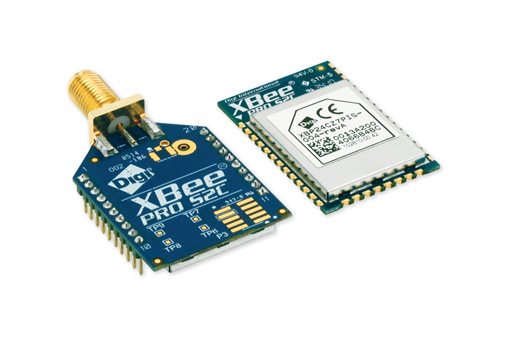ZigBee is a communication protocol used to create personal area networks with small, low-power digital radios. This IEEE 802.15.4 specification, is developed and managed by the ZigBee alliance with major applications in the industrial, scientific and medical industries. Owing to the low data rate, it is preferred in simpler and less expensive wireless networks. Preferred over short ranges of about 20 meters, data can be transmitted over long distances by passing it through a mesh network of intermediate devices.
Hardware
 The radio designs used by zigbee are optimized for low cost in large scale production. It has few analogue stages and use digital circuits wherever possible. The protocols are designed to communicate data through hostile RF environments. The current protocols support beacon and non-beacon enabled networks. In non-beacon-enabled networks, an unslotted CSMA/CA channel access mechanism is used. In this type of network, the routers typically have their receivers continuously active, requiring a more robust power supply. ZigBee devices are basically of three types,
The radio designs used by zigbee are optimized for low cost in large scale production. It has few analogue stages and use digital circuits wherever possible. The protocols are designed to communicate data through hostile RF environments. The current protocols support beacon and non-beacon enabled networks. In non-beacon-enabled networks, an unslotted CSMA/CA channel access mechanism is used. In this type of network, the routers typically have their receivers continuously active, requiring a more robust power supply. ZigBee devices are basically of three types,
Coordinator: The network topologies of a zigbee network require a coordinator node for controlling the data transmission in the network. The coordinator stores information about the network and acts as a repository for security keys.
Router: As well as running an application function, a Router can act as an intermediate router, passing on data from other devices.
End devices: These are the end devices equipped with sensors to measure some parameter. These can only transfer data to either the router or the coordinator. Since the end devices can’t do anything else, this preserves power and increases their battery life.
The below presentation takes a look at some aspects related with ZigBee.
Network properties
ZigBee builds on the physical layer and media access control defined in IEEE standard 802.15.4 for low-rate WPANs. WPAN Low Rate is the newest and provides specifications for devices that have low data rates, consume very low power and are thus characterized by long battery life. It operates in the ISM band i.e. 2.4 GHz worldwide except 784 MHz in China, 868 MHz in Europe and 915 MHz in the USA and Australia. It is also more economical than Wi-Fi and Bluetooth which makes it simpler. The devices can run for years on inexpensive batteries for a host of monitoring and control applications. The network layer support star and tree networks and mesh networking.
Applications
Zigbee is intended for embedded applications with low power consumption and low data rates. Mobility is a constraint; hence it is not suitable with radio equipment. Typical application areas include,
- Automation system,
- Wireless sensor networks,
- Industrial control
- Medical data collection
- Smoke alarms
Feel interested? More available at the learning corner.












well explained. thank you
You are most welcome.